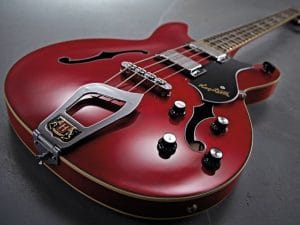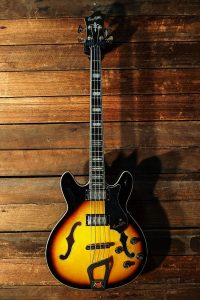Features
Table of Contents
With semi-acoustic basses like Gibsons, Epiphones and Guilds enjoying a spell of popularity after years in the desert, it’s a fine time for the Viking to return. Review by Gareth Morgan Albin Hagström established the Hagstrom brand in Sweden in 1925 to import accordions from Germany and Italy. They began making guitars in 1958, and basses followed three years later. In 1983 Hagstroms disappeared, but the last seven years has seen a resurgence of the brand, with production now based in China. Hagstrom’s Viking guitar and Concord bass first appeared in 1965, and now over 40 years later, the bass – renamed the Viking – is back. The basic body of the Viking Bass is identical to the guitar version. Which paid tribute to Gibson’s popular ES-335 and its sister bass the EB-2. It’s made of laminated maple with a pair of f-holes bound in cream and black. The lower one being slightly obscured by a raised, two-ply black pickguard. If you peer through the f-hole you’ll see a wooden block running from neck to bridge, virtually splitting the body into two separate cavities in order to add strength. Minimise feedback and provide a solid anchoring for the pickups and hardware. The top and back are arched and bound in cream with a thin black multi-stripe. Small details which really reinforce the Viking’s classy credentials. 
Design
Hagstrom choose the set-in method to affix the Viking’s maple neck, which is surprisingly slim and fast as well as being short in scale – 775mm/30.75″, to be precise. This is topped off by a black-faced headstock with a wave-like protrusion on its furthest edge. It’s also bound, although this time it’s done in pearloid (as are the maker’s name and emblem). The tuners are sealed Hagstrom units in chrome with Imperial ‘stairstep’ keys; you might describe them as fussy or over-designed, but we rather like the art deco touch. Although it looks very like ebony, the Viking’s fretboard is made of a composite material called Resinator. Hagstrom say it’s a ‘homogeneous wood composite that maintains a strong fundamental harmonic and eliminates wolf tones. Offering the articulate sound of high quality ebony but with more consistency and durability.’ It carries 21 medium nickel frets, pearloid block inlays and is bound in cream to match the body. The bridge is a chrome tunomatic that can be adjusted using a flat head screwdriver and an Allen key. And the strings are anchored by a Guild-alike Hagstrom ‘harp’ trapeze tailpiece that bears the company’s coat of arms. 
Sounds
We started with the rotary switch in position 1: both pickups in single-coil mode. This sound is fairly modern, with a zingy high-mids bias. This character comes over especially strongly on the D and G strings, and overall it gives crisp, detailed notes without being annoyingly nasal. There’s some growl but the bottom end is smooth and slightly undefined, making this a good notch for general modern rock. Click to position 2 – bridge pickup, single-coil mode. And the sound is informed by the same high-mids definition rather than dominated by it, and the output level is excellent. Definition is tight, the bottom end is wide. And a hint of burpy gurgle means this option works rather well in modern pop or funk. If you’re waiting for evidence of the semi-hollowbody influence. It’s provided by the position 3, the neck pickup in single coil mode. 
Verdict
Modern amps are making semi-acoustic basses more adaptable and controllable that ever before. And this Hagstrom would be a good place to start. The build quality is good, the price is reasonable. And the only real issue is neck-heaviness. Vintage and modern tones? Not quite, but the Viking isn’t a one-trick pony thanks to the rotary control’s six different starting points. All of which have their uses, and the change from humbucker single coil mode (and vice versa) is also a handy feature. We advise you to offer little resistance to this Viking invasion.

Leave a Reply
You must be logged in to post a comment.